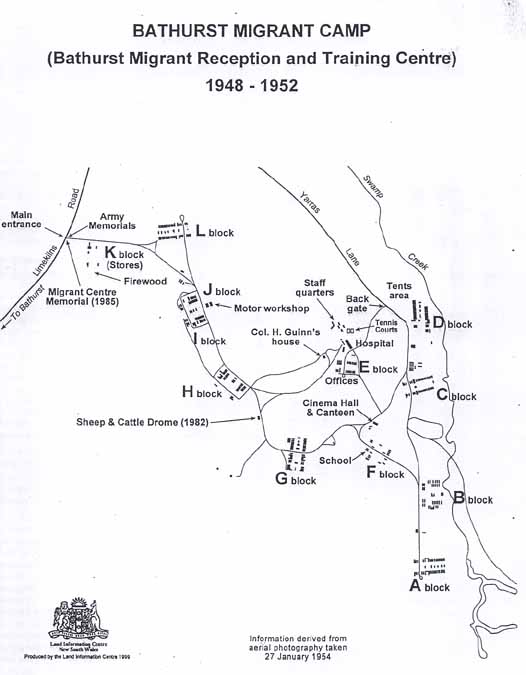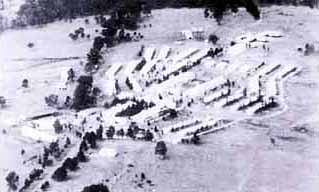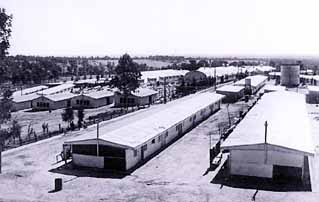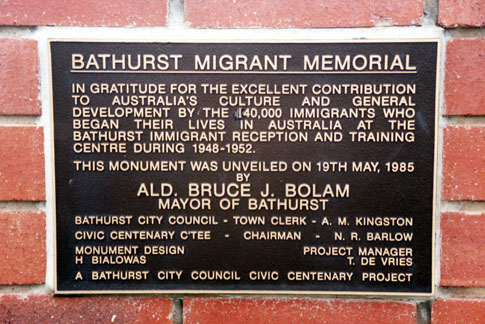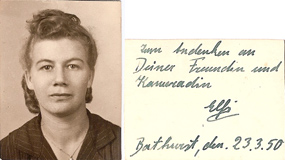Bathurst 1948-1952
by
Janina janina@exemail.com.au
Bathurst is approximately 172 kms northwest of Sydney and Bathurst
Migrant Camp site had been an ex Army Camp which was geographically
isolated from the main township. Basically the accommodation was in the
ex-army style, i.e., unlined and unheated iron sheds and timber barracks
which were freezing in winter and hot in summer. This camp was used because
there was an overall housing shortage and, therefore, very little other
accommodation for the migrants. Many of the barracks were in very poor
condition and needed constant repair. For single people, narrow iron beds
set out in dormitory style made up their quarters whilst the married quarters
were partitioned off into separate sections. Either way there was no privacy.
Bathurst Migrant Camp, like the one at Parkes, was in every sense only transient stops before migrants were resettled elsewhere, e.g., Greta Camp, and most migrants only stayed here for weeks or at the most months. Nevertheless, a school operated at Bathurst from January 1949 to May 1952. As part of the overall Assimilation Policy, these classrooms (rooms within barracks) were also used in the evening for Adult Education where the migrants were encouraged to learn utilitarian English and were introduced to the Australian way of life.
At the time of its closure in April 1952, the camp was a fenced area of 3.5 square miles consisting of 11 self-contained residential blocks capable of accommodating up to 6,000 people in reasonable comfort. The camp housed the usual communal kitchen, school and ablution blocks and was considered to be self-contained township and separate from the wider Bathurst community. However, the ex-army camp had been kitted out to house only 1,500 soldiers so, with the migrant influx, there was the inevitable overcrowding and a tent city was quickly erected. From its initial beginnings as a Migrant Centre (opening on 8th May 1948) till its closure, Bathurst Migrant Centre housed up to 100,000 people with 8,000 being the most at any one time.
Upon arriving in Sydney migrants were quickly put on a train to Kelso Railway Station and were taken by bus to the Migrant Camp. One of the first hurdles for these migrants was the fact that they had to drive through a boom gate which was then lowered immediately afterwards. This reminded many of the labour and concentration camps in Germany and there are many documented accounts of these and similar unsettling experiences.
Despite the difficult conditions, it was at Bathurst Migrant Camp that the first New Australian Opera Company was formed and performed Tosca for the residents of the Camp and for the wider Bathurst audience. Here, in 1949 the first Tygodnik Katolicki (Polish Catholic Weekly) was established and operated until the closure of the Camp when it moved to Melbourne. In 1950, a Polish club was also established here.
In January 1999, there were 3 days of celebration for the migrant camp’s 50th anniversity.
*Brief overview mostly taken from the Bathurst Visitor Information Centre Information sheets.
December
28, 2009
Dear Olga
Thank you for your dedication to such a wonderful site, I have enjoyed visiting
these pages enourmously. I'm sure its a very valuable resource to many people.
In Australia she was resettled at the Bonegilla Migrant Hostel and
probably also Bathurst.
I'm wondering if anyone is able to identify the woman in the photograph for me.
I am grateful for any information however small. I'm interested in knowing the
connection between these two women who were obviously friends.
The back of the photo is signed Zum andenken an deiner Freundin und Kameradin Bathurst 23-3-1950. Can anyone help?
Thank you and Best wishes
Stephanie Benjamin aubenjaminsax@optusnet.com.au, Sydney Australia
